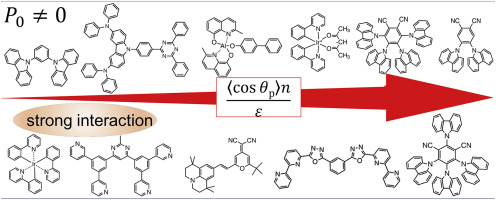Organic Electronics ( IF 2.7 ) Pub Date : 2018-04-12 , DOI: 10.1016/j.orgel.2018.04.026 Kohei Osada , Kenichi Goushi , Hironori Kaji , Chihaya Adachi , Hisao Ishii , Yutaka Noguchi

|
The molecular orientation in organic semiconductor films determines device performances. In particular, the spontaneous orientation of a permanent dipole moment (PDM) along the surface normal direction induces a polarization charge at the hetero-interfaces of stacked multilayer devices, and the interface charge dominates the charge accumulation and injection properties. Spontaneous orientation polarization (SOP) has been observed in the “randomly oriented” films of several organic semiconductor materials, and is potentially inherent in many common materials. Herein, we report that 11 additional molecules of organic light-emitting diode materials, including thermally activated delayed fluorescence emitters, and horizontally oriented emitters and electron transporters, exhibit SOP in their evaporated films. The experimental results clearly indicate that SOP frequently occurs in “horizontally oriented” films as well as “randomly oriented” films. The factors contributing to SOP formation are discussed in terms of the figure of merit per PDM. We found that strong intermolecular interactions tend to reduce the figure of merit. Moreover, we suggest the impact of SOP on device performances.
中文翻译:

有机发光二极管材料蒸发膜中自发取向极化的观察
有机半导体膜中的分子取向决定了器件的性能。特别地,沿着表面法线方向的永久偶极矩(PDM)的自发取向在堆叠的多层器件的异质界面上引起极化电荷,并且该界面电荷支配了电荷的积累和注入特性。在几种有机半导体材料的“随机取向”薄膜中已经观察到自发取向极化(SOP),并且在许多普通材料中可能是固有的。在本文中,我们报道了另外11种有机发光二极管材料分子,包括热激活的延迟荧光发射器,水平取向的发射器和电子传输剂,在其蒸发膜中显示出SOP。实验结果清楚地表明,SOP经常出现在“水平取向”的电影以及“随机取向”的电影中。根据每个PDM的优值,讨论了促成SOP形成的因素。我们发现,强烈的分子间相互作用往往会降低品质因数。此外,我们建议SOP对设备性能的影响。











































 京公网安备 11010802027423号
京公网安备 11010802027423号